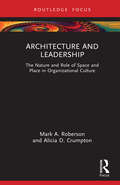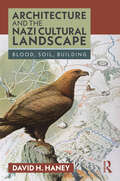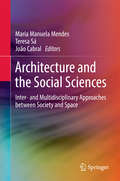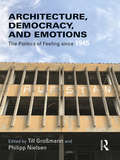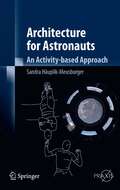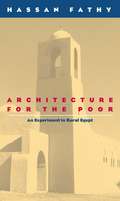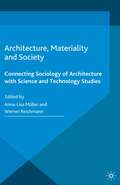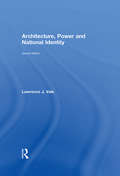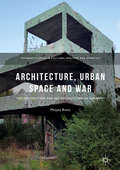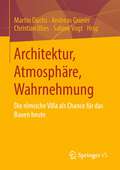- Table View
- List View
Architecture and Leadership: The Nature and Role of Space and Place in Organizational Culture (Leadership Horizons)
by Mark A. Roberson Alicia D. CrumptonFrom cathedrals to cubicles, people go to great lengths and expense to design their living and working environments. They want their spaces to be places where they enjoy being, reflecting who they are and what they care about. The resultant environments in turn become loud, albeit unvocal, leaders for people occupying those corresponding spaces. The design and use of work and living spaces typifies and thematizes expectations for the group. Essentially, the architecture of rooms, buildings and cities creates cultures by conveying explicit and implicit messages. This is evident when people approach and walk into St. Basil’s Cathedral in Moscow, the Forbidden City in Beijing, the Sydney Opera House in Sydney, Australia, the Jewish Museum in Berlin, or the Rothko Chapel in Houston, to name some examples. While leaders oftentimes lack the resources to have their spaces mirror the greatest architectural achievements of the world, they are in a position to use the art and science of architecture, at whatever scale is available, to their advantage. The creative and intentional use of space and place advances and promotes cherished values and enhances organizational effectiveness. This book explores the essence of good architecture and establishes relevant connections for leaders and managers to strategically design and use the organizational workplace and space to support their mission and purpose, and create aesthetically meaningful work environments. It equips leaders to be culturally astute on what defines good architecture and to incorporate principles of beauty in their leadership practices accordingly and will be of interest to researchers, academics, professionals, and students in the fields of leadership, organizational studies, and architecture theory and practice.
Architecture and the Nazi Cultural Landscape: Blood, Soil, Building
by David H. HaneyThis book traces cultural landscape as the manifestation of the state and national community under the Nazi regime, and how the Nazi era produced what could be referred to as a totalitarian cultural landscape.For the Nazi regime, cultural landscape was indeed a heritage resource, but it was much more than that: cultural landscape was the nation. The project of Nazi racial purification and cultural renewal demanded the physical reshaping and reconceptualization of the existing environment to create the so-called "new Nazi cultural landscape." One of the most important components of this was a set of monumental sites thought to embody blood and soil beliefs through the harmonious synthesis of architecture and landscape. This special group of "landscape-bound" architectural complexes was interconnected by the new autobahn highway system, itself thought to be a monumental work embedded in nature. Behind this intentionally aestheticized view of the nation as cultural landscape lay the all-pervasive system of deception and violence that characterized the emerging totalitarian state.This is the first historical study to consider the importance of these monumental sites together with the autobahn as evidence of key Nazi cultural and geographic strategies during the pre-war years. This book concludes by examining racial and nationalistic themes underlying cultural landscape concepts today, against this historic background.
Architecture and the Nazi Cultural Landscape: Blood, Soil, Building
by David H. HaneyThis book traces cultural landscape as the manifestation of the state and national community under the Nazi regime, and how the Nazi era produced what could be referred to as a totalitarian cultural landscape.For the Nazi regime, cultural landscape was indeed a heritage resource, but it was much more than that: cultural landscape was the nation. The project of Nazi racial purification and cultural renewal demanded the physical reshaping and reconceptualization of the existing environment to create the so-called "new Nazi cultural landscape." One of the most important components of this was a set of monumental sites thought to embody blood and soil beliefs through the harmonious synthesis of architecture and landscape. This special group of "landscape-bound" architectural complexes was interconnected by the new autobahn highway system, itself thought to be a monumental work embedded in nature. Behind this intentionally aestheticized view of the nation as cultural landscape lay the all-pervasive system of deception and violence that characterized the emerging totalitarian state.This is the first historical study to consider the importance of these monumental sites together with the autobahn as evidence of key Nazi cultural and geographic strategies during the pre-war years. This book concludes by examining racial and nationalistic themes underlying cultural landscape concepts today, against this historic background.
Architecture and the Social Sciences: Inter- and Multidisciplinary Approaches between Society and Space
by Maria Manuela Mendes Teresa Sá João CabralThis book contributes to current debates on the relationship between architecture and the social sciences, highlighting current interdisciplinary and transdisciplinary teaching as well as research and practice in architecture and urbanism. It also raises awareness about the complementarities and tensions between the spaces of the project, including the construction spaces and living space. It gives voice to recent projects and socio-territorial interventions, focusing on interdisciplinary and multidisciplinary approaches between society and space. Divided into two parts, the first part discusses the possible dialogue between social sciences and architecture, while the second part explores architecture, politics and social change in urban territories from a European perspective.
Architecture and Urbanism in Viceregal Mexico: Puebla de los Ángeles, Sixteenth to Eighteenth Centuries (Routledge Research in Architectural History)
by Juan Luis BurkeArchitecture and Urbanism in Viceregal Mexico presents a fascinating survey of urban history between the sixteenth and eighteenth centuries. It chronicles the creation and development of Puebla de los Ángeles, a city located in central-south Mexico, during its viceregal period. Founded in 1531, the city was established as a Spanish settlement surrounded by important Indigenous towns. This situation prompted a colonial city that developed along Spanish colonial guidelines but became influenced by the native communities that settled in it, creating one of the most architecturally rich cities in colonial Spanish America, from the Renaissance to the Baroque periods. This book covers the city's historical background, investigating its civic and religious institutions as represented in selected architectural landmarks. Throughout the narrative, Burke weaves together sociological, anthropological, and historical analysis to discuss the city’s architectural and urban development.Written for academics, students, and researchers interested in architectural history, Latin American studies, and the Spanish American viceregal period, it will make an important contribution to the field.
Architecture and Urbanism in Viceregal Mexico: Puebla de los Ángeles, Sixteenth to Eighteenth Centuries (Routledge Research in Architectural History)
by Juan Luis BurkeArchitecture and Urbanism in Viceregal Mexico presents a fascinating survey of urban history between the sixteenth and eighteenth centuries. It chronicles the creation and development of Puebla de los Ángeles, a city located in central-south Mexico, during its viceregal period. Founded in 1531, the city was established as a Spanish settlement surrounded by important Indigenous towns. This situation prompted a colonial city that developed along Spanish colonial guidelines but became influenced by the native communities that settled in it, creating one of the most architecturally rich cities in colonial Spanish America, from the Renaissance to the Baroque periods. This book covers the city's historical background, investigating its civic and religious institutions as represented in selected architectural landmarks. Throughout the narrative, Burke weaves together sociological, anthropological, and historical analysis to discuss the city’s architectural and urban development.Written for academics, students, and researchers interested in architectural history, Latin American studies, and the Spanish American viceregal period, it will make an important contribution to the field.
Architecture, Democracy and Emotions: The Politics of Feeling since 1945
by Till Großmann Philipp NielsenAfter 1945 it was not just Europe’s parliamentary buildings that promised to house democracy: hotels in Turkey and Dutch shopping malls proposed new democratic attitudes and feelings. Housing programs in the United Kingdom, the United States, and the Soviet Union were designed with the aim of creating new social relations among citizens and thus better, more equal societies. Architecture, Democracy, and Emotions focuses on these competing promises of consumer democracy, welfare democracy, and socialist democracy. Spanning from Turkey across Eastern and Western Europe to the United States, the chapters investigate the emotional politics of housing and representation during the height of the Cold War, as well as its aftermath post-1989. The book assembles detailed research on how the claims and aspirations of being "democratic" influenced the affects of architecture, and how these claims politicized space. Architecture, Democracy, and Emotions contributes to the study of Europe’s "democratic age" beyond Cold War divisions without diminishing political differences. The combination of an emotional history of democracy with an architectural history of emotions distinguishes the book’s approach from other recent investigations into the interconnection of mind, body, and space.
Architecture, Democracy and Emotions: The Politics of Feeling since 1945
by Till Großmann Philipp NielsenAfter 1945 it was not just Europe’s parliamentary buildings that promised to house democracy: hotels in Turkey and Dutch shopping malls proposed new democratic attitudes and feelings. Housing programs in the United Kingdom, the United States, and the Soviet Union were designed with the aim of creating new social relations among citizens and thus better, more equal societies. Architecture, Democracy, and Emotions focuses on these competing promises of consumer democracy, welfare democracy, and socialist democracy. Spanning from Turkey across Eastern and Western Europe to the United States, the chapters investigate the emotional politics of housing and representation during the height of the Cold War, as well as its aftermath post-1989. The book assembles detailed research on how the claims and aspirations of being "democratic" influenced the affects of architecture, and how these claims politicized space. Architecture, Democracy, and Emotions contributes to the study of Europe’s "democratic age" beyond Cold War divisions without diminishing political differences. The combination of an emotional history of democracy with an architectural history of emotions distinguishes the book’s approach from other recent investigations into the interconnection of mind, body, and space.
Architecture for Astronauts: An Activity-based Approach (Springer Praxis Books)
by Sandra Häuplik-MeusburgerLiving and working in extra-terrestrial habitats means being potentially vulnerable to very harsh environmental, social, and psychological conditions. With the stringent technical specifications for launch vehicles and transport into space, a very tight framework for the creation of habitable space is set. These constraints result in a very demanding “partnership” between the habitat and the inhabitant. This book is the result of researching the interface between people, space and objects in an extra-terrestrial environment. The evaluation of extra-terrestrial habitats in comparison to the user’s perspective leads to a new framework, comparing these buildings from the viewpoint of human activity. It can be used as reference or as conceptual framework for the purpose of evaluation. It also summarizes relevant human-related design directions. The work is addressed to architects and designers as well as engineers.
Architecture for the Poor: An Experiment in Rural Egypt
by Hassan FathyArchitecture for the Poor describes Hassan Fathy's plan for building the village of New Gourna, near Luxor, Egypt, without the use of more modern and expensive materials such as steel and concrete. Using mud bricks, the native technique that Fathy learned in Nubia, and such traditional Egyptian architectural designs as enclosed courtyards and vaulted roofing, Fathy worked with the villagers to tailor his designs to their needs. He taught them how to work with the bricks, supervised the erection of the buildings, and encouraged the revival of such ancient crafts as claustra (lattice designs in the mudwork) to adorn the buildings.
Architecture for the Poor: An Experiment in Rural Egypt
by Hassan FathyArchitecture for the Poor describes Hassan Fathy's plan for building the village of New Gourna, near Luxor, Egypt, without the use of more modern and expensive materials such as steel and concrete. Using mud bricks, the native technique that Fathy learned in Nubia, and such traditional Egyptian architectural designs as enclosed courtyards and vaulted roofing, Fathy worked with the villagers to tailor his designs to their needs. He taught them how to work with the bricks, supervised the erection of the buildings, and encouraged the revival of such ancient crafts as claustra (lattice designs in the mudwork) to adorn the buildings.
Architecture, Materiality and Society: Connecting Sociology of Architecture with Science and Technology Studies
by Anna-Lisa Müller Werner ReichmannThis book examines the extent to which the insights of STS can be used to analyse the role of architecture in and for social life. The contributions examine the question of whether architecture and thus materiality as a whole has agency. The book also proposes a theoretical and methodological approach on how to research architecture's agency.
The Architecture of Illegal Markets: Towards an Economic Sociology of Illegality in the Economy
by Jens Beckert Matías DeweyFrom illegal drugs, stolen artwork, and forged trademarks, to fraud in financial markets - the phenomenon of illegality in market exchanges is pervasive. Illegal markets have great economic significance, have relevant social and political consequences, and shape economic and political structures. Despite the importance of illegality in the economy, the field of economic sociology unquestioningly accepts the premise that the institutional structures and exchanges taking place in markets are law-abiding in nature. This volume makes a contribution to changing this. Questions that stand at the centre of the chapters are: What are the interfaces between legal and illegal markets? How do demand and supply in illegal markets interact? What role do criminal organizations play in illegal markets? What is the relationship between illegality and governments? Is illegality a phenomenon central to capitalism? Anchored in economic sociology, this book contributes to the analysis and understanding of market exchanges in conditions of illegality from a perspective that focuses on the social organization of markets. Offering both, theoretical reflections and case studies, the chapters assembled in the volume address the consequences of the illegal production, distribution, and consumption of products for the architecture of markets. It also focuses on the underlying causes and the political and social concerns stemming from the infringement of the law.
The Architecture of Illegal Markets: Towards an Economic Sociology of Illegality in the Economy
From illegal drugs, stolen artwork, and forged trademarks, to fraud in financial markets - the phenomenon of illegality in market exchanges is pervasive. Illegal markets have great economic significance, have relevant social and political consequences, and shape economic and political structures. Despite the importance of illegality in the economy, the field of economic sociology unquestioningly accepts the premise that the institutional structures and exchanges taking place in markets are law-abiding in nature. This volume makes a contribution to changing this. Questions that stand at the centre of the chapters are: What are the interfaces between legal and illegal markets? How do demand and supply in illegal markets interact? What role do criminal organizations play in illegal markets? What is the relationship between illegality and governments? Is illegality a phenomenon central to capitalism? Anchored in economic sociology, this book contributes to the analysis and understanding of market exchanges in conditions of illegality from a perspective that focuses on the social organization of markets. Offering both, theoretical reflections and case studies, the chapters assembled in the volume address the consequences of the illegal production, distribution, and consumption of products for the architecture of markets. It also focuses on the underlying causes and the political and social concerns stemming from the infringement of the law.
An Architecture of Place: Topology in Practice
by Randall S. LindstromChallenging mainstream architecture’s understandings of place, this book offers an illuminating clarification that allows the idea’s centrality, in all aspects of everyday design thinking, to be rediscovered or considered for the first time.Rigorous but not dense, practical but not trivialising, the book unfolds on three fronts. First, it clearly frames the pertinent aspects of topology—the philosophy of place—importantly differentiating two concepts that architecture regularly conflates: place and space. Second, it rejects the ubiquitous notion that architecture “makes place” and, instead, reasons that place is what makes architecture and the built environment possible; that place “calls” for and to architecture; and that architecture is thus invited to “listen” and respond. Finally, it turns to the matter of designing responses that result not just in more places of architecture (demanding little of design), nor merely in architecture with some “sense of place” (demanding little more), but, rising above those, responses that constitute an architecture of place (demanding the greatest vigilance but offering the utmost freedom).Opening up a term regarded as so common that its meaning is seldom considered, the author reveals the actual depth and richness of place, its innateness to architecture, and its essentiality to practitioners, clients, educators, and students—including those in all spatial disciplines.
An Architecture of Place: Topology in Practice
by Randall S. LindstromChallenging mainstream architecture’s understandings of place, this book offers an illuminating clarification that allows the idea’s centrality, in all aspects of everyday design thinking, to be rediscovered or considered for the first time.Rigorous but not dense, practical but not trivialising, the book unfolds on three fronts. First, it clearly frames the pertinent aspects of topology—the philosophy of place—importantly differentiating two concepts that architecture regularly conflates: place and space. Second, it rejects the ubiquitous notion that architecture “makes place” and, instead, reasons that place is what makes architecture and the built environment possible; that place “calls” for and to architecture; and that architecture is thus invited to “listen” and respond. Finally, it turns to the matter of designing responses that result not just in more places of architecture (demanding little of design), nor merely in architecture with some “sense of place” (demanding little more), but, rising above those, responses that constitute an architecture of place (demanding the greatest vigilance but offering the utmost freedom).Opening up a term regarded as so common that its meaning is seldom considered, the author reveals the actual depth and richness of place, its innateness to architecture, and its essentiality to practitioners, clients, educators, and students—including those in all spatial disciplines.
Architecture, Power and National Identity
by Lawrence ValeThe first edition of Architecture, Power, and National Identity, published in 1992, has become a classic, winning the prestigious Spiro Kostof award for the best book in architecture and urbanism. Lawrence Vale fully has fully updated the book, which focuses on the relationship between the design of national capitals across the world and the formation of national identity in modernity. Tied to this, it explains the role that architecture and planning play in the forceful assertion of state power. The book is truly international in scope, looking at capital cities in the United States, India, Brazil, Sri Lanka, Kuwait, Bangladesh, and Papua New Guinea.
Architecture, Power and National Identity
by Lawrence ValeThe first edition of Architecture, Power, and National Identity, published in 1992, has become a classic, winning the prestigious Spiro Kostof award for the best book in architecture and urbanism. Lawrence Vale fully has fully updated the book, which focuses on the relationship between the design of national capitals across the world and the formation of national identity in modernity. Tied to this, it explains the role that architecture and planning play in the forceful assertion of state power. The book is truly international in scope, looking at capital cities in the United States, India, Brazil, Sri Lanka, Kuwait, Bangladesh, and Papua New Guinea.
Architecture, Urban Space and War: The Destruction and Reconstruction of Sarajevo (Palgrave Studies in Cultural Heritage and Conflict)
by Mirjana RisticThis book investigates architectural and urban dimensions of the ethnic-nationalist conflict in Sarajevo, the capital of Bosnia and Herzegovina, during and after the siege of 1992–1995. Focusing on the wartime destruction of a portion of the cityscape in central Sarajevo and its post-war reconstruction, re-inscription and memorialization, the book reveals how such spatial transformations become complicit in the struggle for reconfiguration of the city’s territory, boundaries and place identity. Drawing on original research, the study highlights the capacities of architecture and urban space to mediate terror, violence and resistance, and to deal with heritage of the war and act a catalyst for ethnic segregation or reconciliation. Based on a multi-disciplinary methodological approach grounded in architectural and urban theory, the spatial turn in critical social theory and assemblage thinking, as well as techniques of spatial analysis, in particular morphological mapping, the book provides an innovative spatial framework for analyzing the political role of contemporary cities.
Architecture, Urban Space and War: The Destruction and Reconstruction of Sarajevo (Palgrave Studies in Cultural Heritage and Conflict)
by Mirjana RisticThis book investigates architectural and urban dimensions of the ethnic-nationalist conflict in Sarajevo, the capital of Bosnia and Herzegovina, during and after the siege of 1992–1995. Focusing on the wartime destruction of a portion of the cityscape in central Sarajevo and its post-war reconstruction, re-inscription and memorialization, the book reveals how such spatial transformations become complicit in the struggle for reconfiguration of the city’s territory, boundaries and place identity. Drawing on original research, the study highlights the capacities of architecture and urban space to mediate terror, violence and resistance, and to deal with heritage of the war and act a catalyst for ethnic segregation or reconciliation. Based on a multi-disciplinary methodological approach grounded in architectural and urban theory, the spatial turn in critical social theory and assemblage thinking, as well as techniques of spatial analysis, in particular morphological mapping, the book provides an innovative spatial framework for analyzing the political role of contemporary cities.
Architectures for Quality of Service in the Internet: International Workshop, Art-QoS 2003, Warsaw, Poland, March 24-25, 2003, Revised Papers (Lecture Notes in Computer Science #2698)
by Wojciech Burakowski Berthold Koch Andrzej BebenThe thoroughly refereed postproceedings of the International Workshop on Architectures for Quality of Service in the Internet, Art-QoS 2003, held in Warsaw, Poland, in March 2003. The 22 revised full papers presented were carefully reviewed and selected for inclusion in the book. The papers are organized in topical sections on architectures for next generation networks, architectures and services, signalling, admission control, AQUILA-resource control, AQUILA-QoS at work, MPLS traffic engineering, and traffic control mechanisms.
Architectures of Emergency in Turkey: Heritage, Displacement and Catastrophe (Contemporary Turkey)
by Eray Çayli Pinar Aykac Sevcan ErcanChallenging existing political analyses of the state of emergency in Turkey, this volume argues that such states are not merely predetermined by policy and legislation but are produced, regulated, distributed and contested through the built environment in both embodied and symbolic ways.Contributors use empirical critical-spatial research carried out in Turkey over the past decade, exploring heritage, displacement and catastrophes. Contributing to the broader literature on the related concepts of exception, risk, crisis and uncertainty, the book discusses the ways in which these phenomena shape and are shaped by the built environment, and provides context-specific empirical substance to it by focusing on contemporary Turkey. In so doing, it offers nuanced insight into the debate around emergency as well as into recent urban-architectural affairs in Turkey.
Architectures of Emergency in Turkey: Heritage, Displacement and Catastrophe (Contemporary Turkey)
by Eray Çaylı, Pınar Aykaç, and Sevcan ErcanChallenging existing political analyses of the state of emergency in Turkey, this volume argues that such states are not merely predetermined by policy and legislation but are produced, regulated, distributed and contested through the built environment in both embodied and symbolic ways.Contributors use empirical critical-spatial research carried out in Turkey over the past decade, exploring heritage, displacement and catastrophes. Contributing to the broader literature on the related concepts of exception, risk, crisis and uncertainty, the book discusses the ways in which these phenomena shape and are shaped by the built environment, and provides context-specific empirical substance to it by focusing on contemporary Turkey. In so doing, it offers nuanced insight into the debate around emergency as well as into recent urban-architectural affairs in Turkey.
Architektur als Instrument der Markenkommunikation: Die implizite Wirkung gebauter Botschaften (Beiträge zur empirischen Marketing- und Vertriebsforschung)
by Moritz HollmannÜber die Architektur von Gebäuden lassen sich Botschaften formulieren, die von Konsumenten implizit wahrgenommen und verstanden werden. Ihre Interpretation ist das Ergebnis eines Zusammenspiels aus kollektiv angelegten und individuell erlernten Verarbeitungsmustern. Diese ermöglichen es, die Bedeutung gestalterischer Elemente zu entschlüsseln. Die entstehenden Empfindungen und Assoziationen prägen jedoch nicht nur das Verhalten des Betrachters. Sie können sich darüber hinaus auch auf seine Wahrnehmung von Marken übertragen, die ein Gebäude zur Repräsentation nutzen. Moritz Hollmann zeigt auf, wie verschiedene Verarbeitungsmechanismen bei der Assoziationsbildung durch Architektur zusammenwirken. Dabei weist der Autor empirisch nach, dass sich dadurch das Markenimage beeinflussen lässt.
Architektur, Atmosphäre, Wahrnehmung: Die römische Villa als Chance für das Bauen heute
by Martin Düchs Andreas Grüner Christian Illies Sabine Vogt„Nach Rom Architekturstudenten zu schicken heißt, sie für ihr ganzes Leben zu ruinieren.“ (Le Corbusier 1922). Im Sinne dieses Verdikts hat sich die Architekturmoderne radikal von der klassizistischen Tradition abgewandt, in der die antike Baukunst als Schulung, Folie und Muster galt, indem man ihre Formen, Strukturen und Proportionen formalästhetisch analysierte und nachahmte. Doch gab es bereits in der Antike ein anderes Konzept von Architekturverständnis: das sinnliche Erleben von Raumsequenzen und die Gestaltung von Atmosphären. Vorgeführt wird uns ein solches Verständnis in Bauten wie der Villa Hadriana aber auch in den „Villenbriefen“ des römischen Senators Plinius d. J. (um 100 n. Chr.). Von Architekten wurden Letztere lebhaft diskutiert, bis die Moderne jede Beschäftigung mit der Antike „untersagte“.Der Band „Architektur, Atmosphäre, Wahrnehmung“ versammelt nun zehn Beiträge, die wieder alle –mehr oder weniger intensiv – als Ausgangsbasis die Villenbriefe nutzen, allerdings nicht, um mit ihnen einen formalästhetischen Zugriff auf die Antike wiederzubeleben, sondern, weil der von Plinius vorgeführte und in der Forschung bis dato vernachlässigte Blick auf die römische Villa unter dem Aspekt einer sequentiellen Sinnlichkeit eine „Chance für das Bauen heute“ ist.Im Ergebnis kann man festhalten: Egal ob man Architekturstudenten nach Rom schickt oder nicht – in jedem Fall sollte man sie Plinius lesen lassen.
